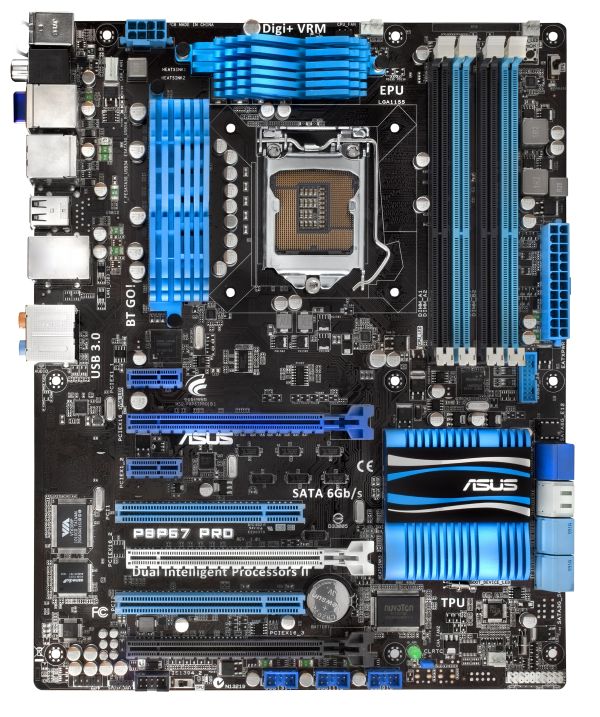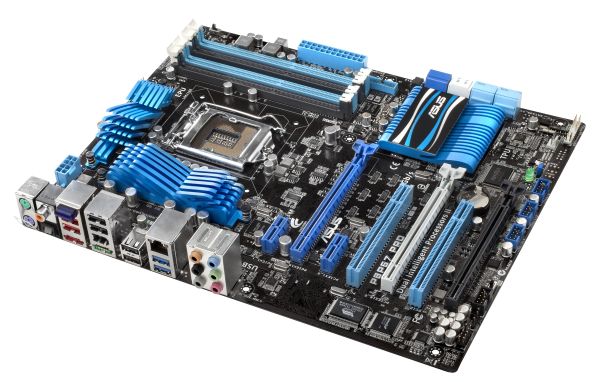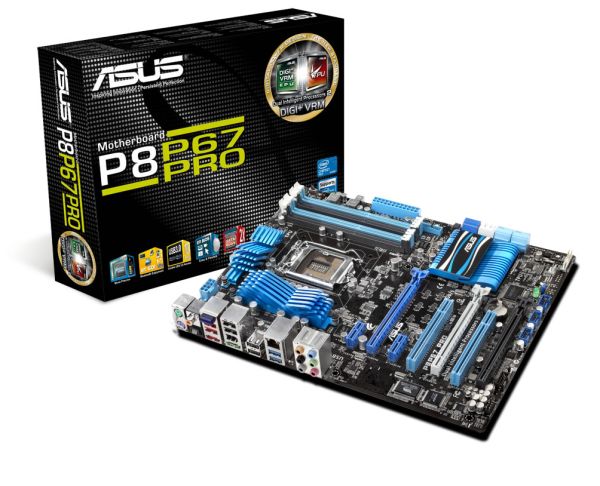The Battle of the P67 Boards - ASUS vs. Gigabyte at $190
by Ian Cutress on January 20, 2011 4:15 PM EST- Posted in
- Motherboards
- Gigabyte
- Asus
- P67
The ASUS P8P67 Pro fits near the beginning of the line-up in the ASUS launch, which in terms of ATX sized boards include the P8P67, the P8P67 Pro, the P8P67 Evo, the P8P67 Deluxe, the Sabertooth P67, the P8P67 WS SuperComputer and the top end Maximus IV Extreme. Therefore, with that in mind, we would expect to be looking at something above the base – slightly more (or better) features than the cheap boards available, enough to warrant the price difference. An overview of the P8P67 series is below:
| P8P67 Series | ||||||
| P8P67 LE | P8P67 | P8P67 PRO | P8P67 EVO | P8P67 Deluxe | ||
| Price | $140 | $160 | $190 | $210 | $235 | |
|
SATA 6 Gb/s SATA 3 Gb/s eSATA |
3 4 1 |
4 4 1 (bracket) |
4 4 2 |
4 4 2 |
4 4 2 |
|
|
CrossFireX SLI |
Yes No |
Yes No |
Yes Yes |
Yes Yes |
Yes Yes |
|
|
USB 3.0 USB 2.0 |
2 14 |
4 (2 via header) 12 |
||||
| LAN | 1 | 1 | 1 | 2 | 2 | |
| Bluetooth | No | Yes | Yes | Yes | Yes | |
Visual Inspection
ASUS have gone with the blue/white/black livery for the Pro board, with a 12+2 digital VRM design covered by slanted blue heat sinks. The socket itself is relatively clear, easily allowing large 1155/1156 CPU coolers to be fitted (remember, 1155 mounting holes are the same as 1156). The CPU fan header is located at roughly one o’clock from the socket itself, with a chassis header to the right of the DIMM slots, presumably for HDD bay type fans.
Next to this header are the EPU switch and the MemOK buttons. The EPU switch enables Energy Processing Unit, which is geared towards saving energy – this encompasses power gating certain features that are never used/used rarely, and declocking when less compute is required. The MemOK button is a physical override for overclocked memory – by holding it down until the red light comes on, at next boot, the UEFI will override the memory settings to something more suitable.
The SATA connectors come in blue (SATA 3 Gb/s), white/grey (SATA 6 Gb/s provided by the chipset) and navy blue (SATA 6 Gb/s provided by a Marvell controller). There is a USB 3.0 header also here, near the DIMM slots. These are all next to the ASUS logo and chipset cooler, which underneath have another chassis header and a green power light. This board is lacking both a debug LED and power/reset buttons on the main board, much to our disappointment.
The PCI slots are well laid out, with a PCIe 1x at the top and enough space between the first two PCIe x16 for a PCI card, meaning that at least one is available if all three PCIe x16 are occupied with dual slot cards. The black PCIe x16 slot is wired up as an x4 slot (as it shares bandwidth with the x1 slots, two USB 3.0 ports and the eSATA ports), and with a dual slot card in there, will cover most of the board USB headers.
The TPU switch is underneath the PCI slots, and performs the same function as the TurboV EVO software in the OS to optimise the system for a decent and stable overclock.
The back panel is standard, with dual PS/2 connectors, SPDIF outputs, USB 2.0 slots, USB 3.0 slots, Firewire, eSATA, audio and Ethernet. The blue module three from the left is the ASUS Bluetooth module, designed to communicate with Bluetooth devices to enhance overclocking or utilise music management. The gigabit Ethernet is handily powered by an Intel chip.














137 Comments
View All Comments
Rick83 - Friday, January 21, 2011 - link
An ASUS Xonar DX costs around 50-70$ and does the same, and remains portable to any pcie board. I chose to go with that in the end...sweetspot - Friday, January 21, 2011 - link
See this is the point exactly overlooked,""go get so and so sound card to solve your problems, but now look at the equation posted in the review ""
2x 190 mobos or the 150 mobo which is better save 40 bucks ??
See how can you save 40 bucks when they clearly did not do sound review at all, so you now need to go pay the extra 50-70 bucks for add on sound card, now you are not saving 40 bucks with the Asrock board are ya.
Sure reader can go elsewhere and do alot of extra research on the parts for that info, but the review sites are supposed to cover that whcih is the whole reason people read them in the 1st place to get info they dont have access to read and not have to go web hopping for each detail to get information, and let an expert reviewer cover that research and testing for them, the whole reason review sites exsist. leaving out details so readers have to go elsewhere for items they reviewed is not a very helpfull at all, and readers waste time reading this to find out they are SOL later on, and need to spend more time on other sites for overlooked details.
Sound is not small item or bug oversite, every mobo computer usually sound is a key part of their use for home / entertainment use types. So skipping sound and other mojor compnents in a review is terrible to the reader.
Voldenuit - Friday, January 21, 2011 - link
Blegh. Too expensive.Pass.
Concillian - Friday, January 21, 2011 - link
Agree.Seen a fair number of reviews of various $150+ P67 boards.
OCing the 2500k looks to be about as non-complex as it gets, does a mobo really make a big difference anymore aside from 20 phase VRMs or whatever for the people doing water and phase change cooling and pumping 1.5 volts through these things?
Seems like a normal person on air going for 4.4-4.6 should need nothing fancy except whatever pci-E slot config and ports they are after.
I'm waiting on a <$150 roundup somewhere.
Rick83 - Friday, January 21, 2011 - link
The worst part, is that I got a p55 UD5 for 150 euro, which has more features than the new UD5. (And cost less at launch)I don't even want to talk about the feature-decay with regard to my IP35 Pro.
It's a sad state for the mobo buyer and best to stick to the low end.
Cashano - Friday, January 21, 2011 - link
I read a lot of comments about wait for the (X/Z)(67/68) boards, problem is by then AMD is on the playing field with they new chipset and boards, but lets look at todays boards.When testing boards at $190, i would say its more fitting to test the ASRock P67 Extreme6 instead of the ASRock P67 Extreme4, seeing that its closer to the $190 mark and alot more SATA and V16 power, but thats just what I think.
Cashano.
Cashano - Friday, January 21, 2011 - link
Forgot to add, that Ext6 has 2x 1Gbit LAN, or combined 2Gbit :P new feature.Cashano
seamusmc - Friday, January 21, 2011 - link
Who really uses that feature though. I've never met anyone that takes advantage of that. Would be neat to try it.Hogan773 - Friday, January 21, 2011 - link
No - the POINT is that you compare based on what you GET and the ASRock is delivering all the features (and more) vs the $190 tier at both ASUS and GB.Maybe you're different, but when I buy something, my thought process is not "OK how much to I want to spend" but rather "what features do I want to buy" and from there, where can I get the lowest dollar price on said features.
BTW beyond the bigger power phases there doesn't seem to be that many diffs between the ASR 4 and ASR 6. Thats prob because the ASR 4 is pretty fully loaded.
Cashano - Friday, January 21, 2011 - link
You are right that there isn't a lot of difference between X4 and 6, from what i can see it is,X6 has 2x SATA3(raid), 4x SATA3(raid), 4x SATA2(raid), and V16+2 phase power, and Dual Lan.
X4 has 2x SATA3(raid), 2x SATA3(raid), 4x SATA2(raid), and V8+2 phase power, and Single Lan.
I don't know the price difference is in the US, I think its down to about $10.
Well my thought process is, what do I need here and now for cheapest price, and what do I need in 3 to 6 months, for expansion and upgrades (like crossfire and hard disk's) but that's just me.
But yes I would take the X4 over X6 if i didn't use Dual lan, or used 2 Raid setups.
Cashano